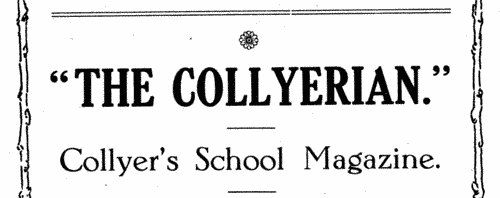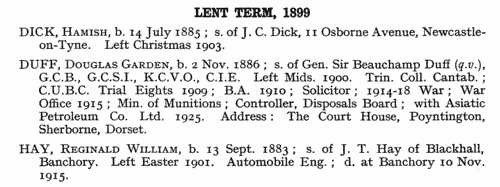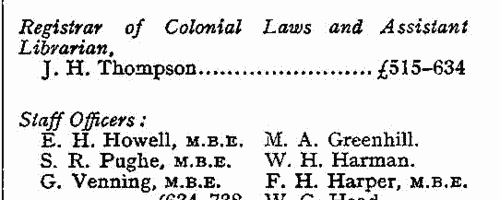Add this eBook to your basket to receive access to all 59 records. Our indexes include entries for the spelling christison. In the period you have requested, we have the following 59 records (displaying 41 to 50): These sample scans are from the original record. You will get scans of the full pages or articles where the surname you searched for has been found. Your web browser may prevent the sample windows from opening; in this case please change your browser settings to allow pop-up windows from this site. Gardeners of Country Houses in Surrey
(1917)
The Horticultural Directory and Year Book was published for 57 years by the proprietors of the Journal of Horticulture, but for 1917 it was acquired by the Gardeners' Chronicle, and a complete revision was undertaken. 'In order to ensure the accuracy of the entries, enquiries were sent to every one of the many thousand persons whose names appeared in the lists. Nor did the work cease there, for in cases where no reply was received, a second enquiry, and in some instances even a third, was sent out. Inasmuch as the War has called many gardeners from their normal avocations, it was not possible to obtain information with respect to all the changes which occurred during the year, and particularly during the closing months. It became necessary, therefore, either to go to press with a certain number of unverified entries or to omit them altogether. After careful consideration, the latter course was adopted, and every unverified entry has been omitted.'
Pages 75 to 187 of the work are occupied by 'A County Directory of the Principal Gardens in Great Britain and Ireland, including Name of Proprietor, Gardener, and Post Town.' This lists country houses possessing substantial gardens tended by a professional gardener. | Sample scan, click to enlarge

| Residents of East Africa
(1922)
The East African Standard compiled this directory of residents of Kenya Colony (K.C.) and Protectorate, Uganda Protectorate (U.P. or Ug.), Tanganyika Territory (T.T.) and Zanzibar Sultanate (Z. or Zbr.) | Sample scan, click to enlarge

| Members of the Shorthorn Society
(1924)
Coates's Herd Book, published annually by the Shorthorn Society of Great Britain and Ireland, although mainly devoted to the pedigrees of the cattle, also has some human content. New Series volume 70, for births of cattle in 1923, was published in October 1924. It includes lists of breeders; judges ; owners of beasts that won prizes in 1923; and a list of members of the society corrected to July 1924. In the membership list an obelus before the name indicates a Life Member. | Sample scan, click to enlarge

| Medical Practitioners in Scotland
(1926)
The Medical Directory was split into several sections. The Scottish section covered all medical practitioners resident within Scotland. Each year a schedule was sent to each doctor to be returned to the publishers, so as to keep the directory up to date. In the directory the doctor's name is given first, in bold, surname first, in capitals; then current address. Next are the qualifications; the italic abbreviations in parentheses following the qualifications indicate the medical school at which they were gained. Then there is a list of posts and honours within the profession, starting with those then current; previous posts are preceded by the word 'late'. Finally, brief details are given of any publications. | Sample scan, click to enlarge

| Collyer's School
(1930)
"The Collyerian" is the magazine of Collyer's School, Horsham, in Sussex. Each issue starts with general Notes on News; Valete, listing boys leaving, with date, term and form of entering, house, and conspicuous achievements; Avete, listing new boys by house; and there are reports on school sports, societies, and the old boys' association. The names that occur are predominantly those of the boys, the staff, and the old boys, although not exclusively so; for instance, the cricket scores give the names of members of rival teams. This is volume iii number 24, for July 1930. | Sample scan, click to enlarge

| Boys at University College School
(1901-1931)
In 1830 a school was set up adjoining the University and College of London on Gower Street; the school was enlarged from 1860 to 1876, and then removed to Frognal in 1907. In 1931 this register was published, listing all boys entering the school from Christmas term of 1859 to the summer entrants of 1931. The dates are abbreviated (98-01 = 1898-1901, &c.), each session being reckoned as beginning in September of one year and ending in the July of the next; the date of joining the school is indicated by the former, although it may fall in the latter, but the date of leaving by the latter, although it may fall in the former. Thus, if a boy came at any time during the Session 1863-64 and left any time during 1868-69, his date would be given 1863-69. The boys are listed alphabetically by surname, and then chronologically under each surname, full name being given where known. An asterisk * indicates that that particular boy lost his life in the Great War: in these cases, rank and regiment have been given where possible. Addresses as of 1931 are given where known. Italics in christian names or initials indicate that that particular boy was known, in 1931, to be dead. (a) (b) &c placed before christian names indicates brothers. In some cases occupation in later life is shown (A, artist; B, barrister; C A, chartered accountant; Ch, chemist; E, engineer; H C S, home civil service; I C S, Indian civil service; Med, physician or surgeon; M S E, member of the Stock Exchange; Mus, musician; Rev, minister of religion; S, solicitor). This is the index to those boys who were at the school in the period 1901 to 1931. | Sample scan, click to enlarge

| Members of the Highland & Agricultural Society of Scotland: Dumbarton
(1931)
This list of the 9739 members of the Highland and Agricultural Society of Scotland was printed in 5th series, volume 43, of the society's Transactions. The list, which gives year of admission, full name (surname first) and address, is set out alphabetically by county and show division - Aberdeen, Angus (Eastern and Western districts), Argyll, Ayr, Banff, Berwick, Bute, Caithness, Clackmannan, Dumbarton, Dumfries, East Lothian, Fife, Inverness, Kincardine, Kinross, Kirkcudbright, Lanark, Mid-Lothian, Moray, Nairn, Orkney, Peebles, Perth (Perth and Stirling show districts), Renfrew, Ross & Cromarty, Roxburgh, Selkirk, Shetland, Stirling, Sutherland, West Lothian, and Wigtown, with separate sections for members living in England & Wales, Ireland, The Colonies and Foreign Countries. In addition, prior to 1900 holders of the Agricultural Diploma and the First-Class Certificate in Forestry had been eligible for free life membership, and those surviving are listed separately in an appendix. | Sample scan, click to enlarge

| Boys entering Trinity College, Glenalmond
(1932)
Trinity College, Glenalmond, Perthshire, was originally founded as a college at which young men might be trained for the ministry of the Scottish Episcopal Church, and the sons of the laity might be educated and brought up in the faith and tradition of the Church. In 1876 the Theological College was transferred to Edinburgh, Glenalmond remaining as a boys' school. This second edition of the school register, edited by G. St Quintin, was published in 1955, incorporating the text of the first edition prepared by E. W. Neish. The scholars are listed by term of entering the school, and then alphabetically by surname; the details then given are full christian names, date of birth; name of father; any distinctions within the school; and then a career synopsis, with date and place of death where known. | Sample scan, click to enlarge

| Officers of the British Army and of the Indian Army
(1934)
The Half-Yearly Army List, issued By Authority, 30 June 1934, lists all officers in active service at that date, and this list was evidence of the status and rank of the officers contained in it. The entries are set out as a gradation list, by rank, from field-marshals to lieutenants, and within each rank in order of seniority at that rank. Each officer's name (surname first, in capitals, then christian name and present rank (with date of achieving that rank) and regiment &c. are given, for convenience, in bold type, with any national decorations in italics after the name. Each entry also gives date of birth, number of days service in the ranks, dates of service in each rank of officer, particular offices and postings (with dates) and, where appropriate, a summary of war service, and medals. For all but the oldest of the officers then serving, the war service details are for the Great War (1914-1921), and campaigns in Iraq, Waziristan, and the North West Frontier of India. War services are not given in this edition for Indian Army officers, except in that their entries are preceded by a crossed swords symbol where they have seen war service in a theatre of war overseas. After the gradation list of officers, there is a section for the Royal Malta Artillery; and then (pages 1152 to 1185) warrant officers - staff or garrison serjeant-majors, educational serjeant-majors, serjeant-major (physical training and educational) instructors, regimental serjeant-majors (and corporal-majors, farrier-serjeant majors, master gunners, assistant instructors in gunnery, experimental serjeant-majors, artillery clerks, farrier-serjeant-majors, artificer serjeant-majors, clerks of works, mechanist, superintending clerks, draughtsmen, 1st class staff serjeant-majors, transport, supply, conductors, sub-conductors, armourers, armament artificers, headmasters, schoolmasters, marine gunners, and bandmasters. The section for the Royal Army Chaplains' Department lists all chaplains (1st to 3rd class); and that for Queen Alexandra's Imperial Military Nursing Service has all matrons, sisters and staff nurses. The lists of nurses do not give date of birth: all are unmarried. The book concludes with the Yeomen of the Guard, the Honourable Company of Gentlemen-at-Arms, and the King's Body Guard for Scotland, in each case giving name (surname and initials, not christian names), honours, name of late regiment, and date of appointment.
| Sample scan, click to enlarge

| British Civil Servants
(1935)
The British Imperial Calendar lists civil servants in Britain, arranged according to the organizational structure of the state, and shows their qualifications and salaries. | Sample scan, click to enlarge

|
Research your ancestry, family history, genealogy and one-name study by direct access to original records and archives indexed by surname.
|











